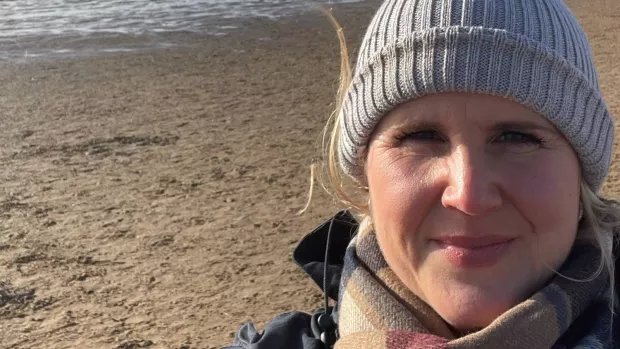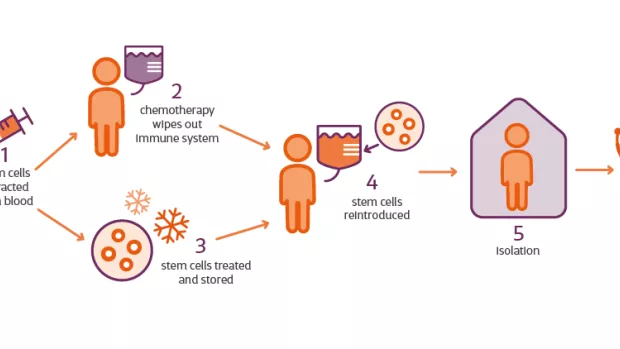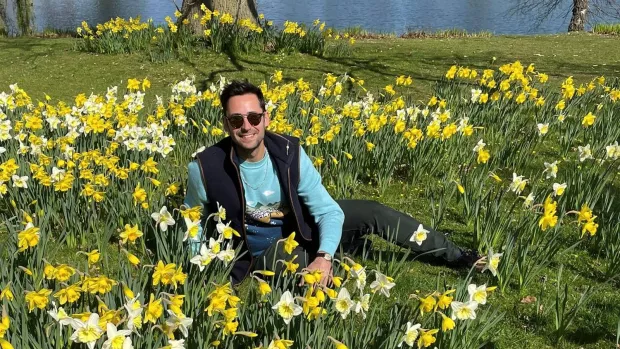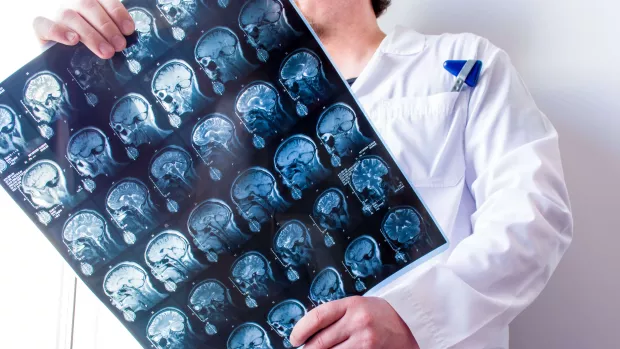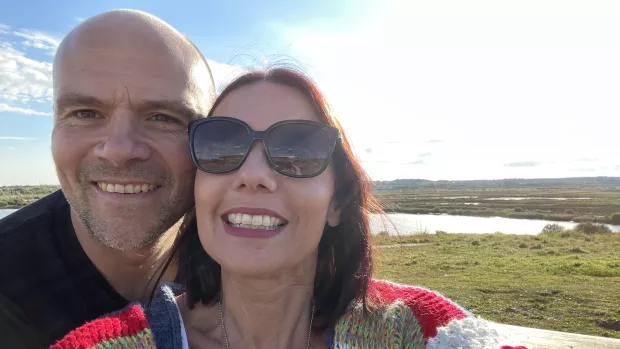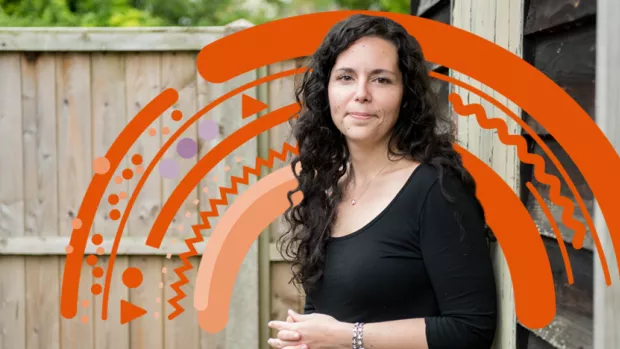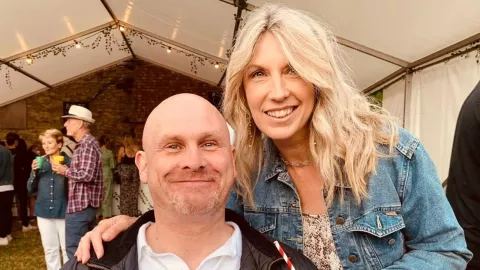
“I’ve got nothing to lose” - Steve and Lucy Kerly's HSCT journey
Lucy Kerly and her husband Steve both had HSCT to treat their MS. Lucy has just had HSCT on the NHS at Hammersmith Hospital in London. Steve travelled to Mexico for his in 2016. Lucy tells us about their experiences and how they’re both getting on.
Steve’s MS diagnosis
Steve was initially diagnosed with relapsing remitting MS in 2003, and secondary progressive MS in 2009. But we feel this may have been wrong. He really didn’t have defined relapses and then recover. He tried five different disease modifying therapies (DMTs) but nothing seemed to work.
He got new symptoms and they remained and slowly progressed. One of the first things was sudden onset of double vision. Steroids did nothing and he remained with this for 10 years until squint surgery corrected it. There was also a gradual decline in his mobility, going from a slight limp, stick, crutches, zimmer to wheelchair by 2014.
Read more about MS signs and symptoms
When we heard about HSCT
In January 2016, we sat having dinner with the kids and a Panorama programme came on about HSCT and MS. We all stopped and watched in shock that we'd never heard of this treatment before.
The following day we went into research mode and joined every Facebook group and forum that mentioned HSCT. It quickly became apparent that Steve would not fit the strict criteria for NHS treatment, so we started looking at the overseas options. Russia declined him due to his EDSS (Expanded Disability Status Scale) of 7.5. However, Mexico were happy to accept him. Now there was just the small matter of costs!
Read more about HSCT outside the NHS
A leap of faith
By June 2016, after six months of fundraising, we were ready to go. We accepted a date for the HSCT in July – short notice, but someone else had cancelled so we took the slot.
Steve’s words were “I’ve got nothing to lose”. He felt the way he was progressing he'd be in a care home by the time he was 50. It was a leap of faith I suppose, it gave us all hope. We knew it wasn’t going to reverse the damage already done, the aim was to halt the progression.
Over the last six years, Steve has remained pretty stable, with an EDSS of 7. Although in the last year, after a nasty urine infection that hospitalised him, his mobility has declined slightly, with more falls. His neurologist will be repeating MRIs to see what’s going on, but he’s no worse than before he went to Mexico so we remain positive.
My MS diagnosis – during COVID
I was diagnosed in 2020. COVID had hit and I was diagnosed over the phone. I went through MRIs and a lumbar puncture and was told I had primary progressive MS.
I didn’t accept it, believed it had to be wrong. Two months later I saw a neurologist and asked if the diagnosis was right. She said yes. I immediately thought, HSCT here we come.
The neurologist said I could start on ocrelizumab (Ocrevus) but I said I wanted to do my research, talk to real people. When I did, not enough people with primary progressive MS gave me hope. I got the impression ocrelizumab wasn’t for me.
Why I chose HSCT
I needed something so I’ll be ok to carry on looking after Steve. And have a future for myself. I firmly believed that could be HSCT.
I went to see another neurologist about ocrelizumab. When I told her about HSCT she said I was far too well for it. But for me, that didn’t make sense, why wait? That was the biggest regret for Steve, that he didn’t get it sooner. It was a no brainer, I was well enough to take it on.
Paying privately to find out more
I started getting help on who to talk to about getting HSCT on the NHS. I understood I needed new lesions within a year on an MRI scan – to show that my MS was “active”. I was told to go and have a private consultation to see if I stood a chance.
I work at my local hospital and asked them to put all my MRI scans on a disc. At the private consultation, they did a new MRI scan and said it looked like I had a least two more lesions since my last MRI. I would fit the criteria for HSCT on the NHS in London. My EDSS was 3.5 because I walk with a bit of a limp and foot drop. The neurologist told me I was an ideal candidate. Apart from my relatively minor MS symptoms I was fit and well and looked after myself.
Read 7 things you need to know about MRI and MS
Getting referred to the NHS for HSCT
He said the next step was to get myself referred to him in his NHS capacity. This was done and I eventually had my first NHS neurology appointment in London in August 2021. At that appointment, I was told my case would be discussed at the multi-disciplinary team meeting.
At the end of October I was told I’d been accepted. What a feeling! I could have grabbed the neurologist and kissed him!
I was referred to the haematologist, who warned me things might be delayed because of the impact of the Omicron variant. But by February things started moving. I had lots of blood tests and an appointment with the transplant team to discuss the whole procedure.
My first round of chemo
My first round of chemo was on 4 March 2022. This was done in an outpatient clinic and I was sent home with tablets and injections to administer at home.
This initial chemo and the G-CSF injections are to encourage the stem cells to come away from the bone marrow. The first few days following the chemo were tough, there was a lot of nausea and vomiting but it subsided on day three.
Read more about G-CSF injections
After five days of injections (which did cause a bit of bone pain) it was back to London for blood tests.
Stem cell harvest and “testing day”
Next step was on the 14 March. This was my stem cell harvest where my stem cells were collected and then frozen. This was also done as an outpatient, so I didn’t stay in hospital.
The next week I was called in for testing day. It’s when they check all your organs are fit and strong enough to endure this procedure. I had a chest X-ray, lung function test, and an ECG and echocardiogram to check my heart and blood vessels.
Admission day – sooner than expected
All the test results were fine, so I was given my admission date. I felt extremely lucky that it was only a few weeks away.
Then a few days later the hospital called. They had space on the ward and could I come in sooner. Four days later I was in hospital ready for my next round of chemo.
The next round of chemo – extremely tough
Over five days I had two different types of chemotherapy, called cyclophosphamide and ATG. And along with that, a constant drip of something called mesna which protects the bladder from the chemo.
I’m not going to lie, it was extremely tough. I felt awful, with severe nausea, vomiting, fluid retention and diarrhoea. I just kept telling myself it will be over soon, short-term pain for long-term gain.
Read more on what to expect from HSCT
A day of rest, then the stem cells and neutropenia
After the chemo was finished, I had one rest day before my stem cells were given back. That was on 4 April – what I call my stem cell birthday.
After this, you go into a phase they call neutropenia. It’s where your immune system has depleted and you’re extremely vulnerable to infections and fevers. I was extremely fortunate and didn’t develop any complications.
Then it’s just a case of waiting till your white blood cell numbers begin to rise again and you’re no longer neutropenic.
Once your white blood cell numbers are back in the safe zone and you’re well you can be discharged. For me, this was on Good Friday. So in less than a year of having the private consultation, it was done. My stem cell transplant was complete! I’ve been so lucky and feel so blessed.
How I’m doing now
Now I’m home and have to allow for recovery. This varies between people, but I was told three to four months. My bloods will be monitored and I’ll have an appointment with the haematologist in May. That’s all to make sure everything is going in the right direction.
Sometimes I worried if I was doing the right thing
I was so well cared for by the haematology and bone marrow transplant team at Hammersmith Hospital and all the staff on Weston Ward. Everyone was friendly and put me at ease. It’s a scary process but not once did I feel they weren’t in control. I felt completely safe.
Sometimes I worried if I was doing the right thing going through this procedure when I’ve got little disability and I’m relatively well. Then I’d quickly tell myself that’s exactly why I’m doing it now, so I can hopefully remain well. I’m Steve's carer and now I can hopefully continue being so
HSCT and the MS Society
We’re working alongside clinicians to help make sure people with MS can get treatments that are right for them at the right time. This includes HSCT for people who are eligible.

